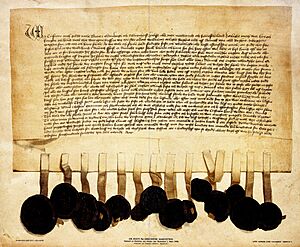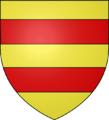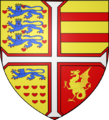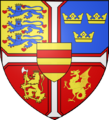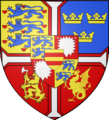Christian I of Denmark facts for kids
Quick facts for kids Christian I |
|
|---|---|
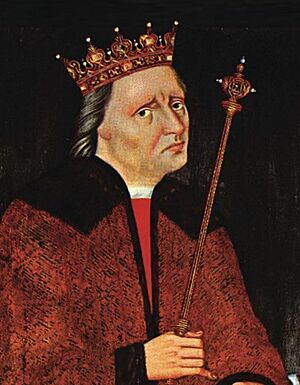
Portrait at Frederiksborg Castle, 15th century
|
|
| King of Denmark (more...) | |
| Reign | 1 September 1448 – 21 May 1481 |
| Coronation | 28 October 1449 Copenhagen Cathedral |
| Predecessor | Christopher III |
| Successor | John |
| King of Norway (more...) | |
| Reign | 13 May 1450 – 21 May 1481 |
| Coronation | 2 August 1450, Trondheim |
| Predecessor | Charles I |
| Successor | John |
| King of Sweden (more...) | |
| Reign | 23 June 1457 – 23 June 1464 |
| Coronation | 29 June 1457, Uppsala |
| Predecessor | Charles VIII |
| Successor | Charles VIII |
| Count of Oldenburg | |
| Reign | 14 February 1440 – 1 September 1448 |
| Predecessor | Dietrich I |
| Successor | Gerhard VI |
| Born | February 1426 Oldenburg, Holy Roman Empire |
| Died | 21 May 1481 (aged 55) Copenhagen Castle |
| Burial | Roskilde Cathedral |
| Spouse |
Dorothea of Brandenburg
(m. 1449) |
| Issue among others... |
|
| House | Oldenburg |
| Father | Dietrich, Count of Oldenburg |
| Mother | Hedvig of Holstein |
Christian I (born February 1426 – died 21 May 1481) was a powerful ruler in Scandinavia. He was a German noble who became king of Denmark (1448–1481), Norway (1450–1481), and Sweden (1457–1464). He was also the Duke of Schleswig and Count (later Duke) of Holstein. Christian I was the very first king from the House of Oldenburg, a royal family that still rules Denmark today.
After King Christopher of Bavaria died without children, there was no clear ruler. Sweden chose Charles VIII of Sweden as their king. Norway also chose Charles the next year. However, the Danish leaders chose Christian to be their king. He later became king of Norway in 1450 and Sweden in 1457. This brought the three kingdoms back together under the Kalmar Union for a short time. In 1463, Sweden left the union again. Christian tried to win it back but lost a big battle in 1471 to Sten Sture the Elder.
In 1460, Christian also became the Duke of Schleswig and Count of Holstein. He inherited these lands after his uncle, Duke Adolphus, passed away.
Contents
Biography
Early Life and Family
Christian was born in February 1426 in Oldenburg, a city in northern Germany. He was the oldest son of Count Dietrich of Oldenburg and his second wife, Hedvig of Holstein. Christian had two younger brothers, Maurice and Gerhard, and a sister named Adelheid.
His family, the House of Oldenburg, had been important rulers in Germany since the 1100s. They had slowly gained control over more land. Christian's father was known as "the Fortunate" because he brought his family's lands back together.
Christian's mother, Hedvig, was related to the rulers of Holstein. His uncle, Duke Adolphus of Schleswig, raised Christian. Duke Adolphus had no children of his own. He wanted Christian to be his heir and helped him get elected as his successor in the Duchy of Schleswig. When his father died in 1440, Christian and his brothers became joint rulers of Oldenburg.
Becoming King of Denmark

In January 1448, King Christopher of Bavaria of Denmark, Sweden, and Norway died suddenly. He had no children, which caused problems for the union of the three kingdoms. Denmark and Sweden chose different paths, and Norway's future was unclear.
The Danish leaders first offered the throne to Duke Adolphus of Schleswig. He was a very important lord in Denmark. But the Duke said no and suggested his nephew, Christian of Oldenburg, instead.
Before Christian could become king, he had to make some promises. He agreed not to rule both Schleswig and Denmark at the same time. The leaders also said he had to marry dowager queen Dorothea of Brandenburg. She was the widow of the previous king, Christopher III.
On 1 September 1448, Christian signed his promises and was chosen as King Christian I of Denmark. His coronation happened on 28 October 1449, in Copenhagen. His marriage to Queen Dorothea was also celebrated that day.
Ruling Sweden and Norway

While Denmark was choosing Christian, Sweden had already picked Charles VIII of Sweden as their king in June 1448. Norway then had to decide if it would join Denmark or Sweden, or choose its own king. Choosing their own king was quickly ruled out.
There was a struggle between those who supported Christian and those who supported Charles. The Norwegian council was divided. In February 1449, some council members chose Charles as king. But in June, others supported Christian. On 20 November, Charles was crowned king of Norway.
However, the Swedish nobles wanted to avoid war with Denmark. In June 1450, the Swedish council made Charles give up his claim to Norway. In the summer of 1450, Christian sailed to Norway with a large fleet. On 2 August, he was crowned king of Norway in Trondheim.
On 29 August, Denmark and Norway signed a treaty in Bergen. This treaty said that Norway, like Denmark, would be an elective monarchy. This meant the king would be chosen, not just inherited. The treaty also stated that Denmark and Norway would always have the same king. This king would be chosen from the previous king's sons, if there were any.
Charles Knutsson became very unpopular as king of Sweden. He was forced to leave in 1457. Christian then achieved his goal of being elected king of Sweden. This brought the Kalmar Union back together. However, Sweden was often divided, and Christian's rule there ended in 1464. He was defeated in the Battle of Brunkeberg in October 1471, when he tried to regain Sweden. Christian continued to claim the Swedish throne until he died in 1481.
Becoming Duke and Count
In 1460, King Christian also became the Duke of Schleswig and the Count of Holstein-Rendsburg. He inherited these lands after his uncle, Duke Adolphus VIII, died without children in December 1459.
Christian's claim to these lands was confirmed by the nobles and representatives of these areas in Ribe on 5 March 1460. In 1474, the Holy Roman Emperor Frederick III made Christian the Duke of Holstein. This made Holstein an important territory directly under the Emperor.
Later Years and Legacy
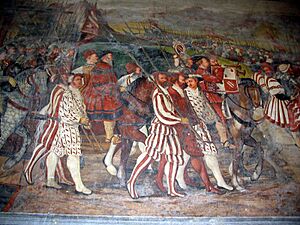
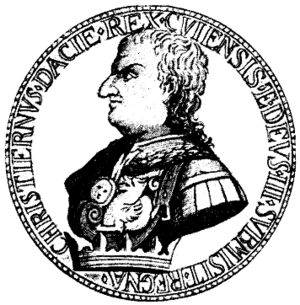
Christian's lands were largest between 1460 and 1464, before Sweden left the union. But many parts of his kingdom wanted to rule themselves, leading to constant struggles. Denmark was his most important center of power.
In 1474, Christian traveled to Milan and Rome in Italy. He met with Pope Sixtus IV. Later that year, he visited Charles the Bold in Burgundy. He stayed in Burgundy for several months, moving to the Netherlands in early 1475.

With permission from Pope Sixtus IV, Christian founded the University of Copenhagen. It opened on 1 June 1479.
Christian I died at Copenhagen Castle on 21 May 1481, when he was 55 years old. He was buried in the Chapel of the Magi at Roskilde Cathedral. This beautiful chapel was built by Christian and Queen Dorothea to be a burial place for their family. Their graves are marked with simple stones.
The royal family he started, the House of Oldenburg, still rules Denmark today. They also ruled Norway for a time and returned to the throne there in 1905. They also ruled Sweden during Christian's time and later.
Arms
Issue
| Name | Birth | Death | Notes |
|---|---|---|---|
| Olaf | 1450 | 1451 | |
| Canute | 1451 | 1455 | |
| John | 2 February 1455 | 20 February 1513 | King of Denmark, Norway and Sweden. Had issue. |
| Margaret | 23 June 1456 | 14 July 1486 | Married King James III of Scotland in 1469. Had issue. |
| Frederick I | 7 October 1471 | 10 April 1533 | King of Denmark and Norway. Had issue. |
See also
- List of Danish monarchs
- Danish monarch's family tree


